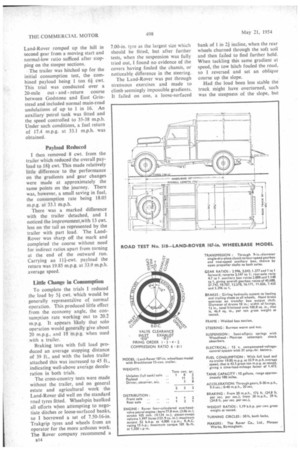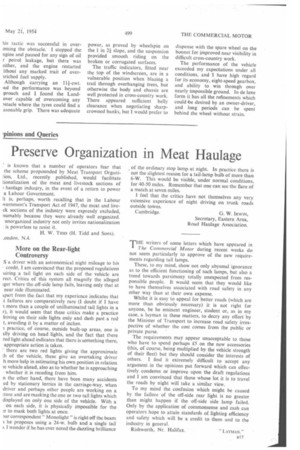Smooth and Willing the Big Land-Rover
Page 46

Page 47

Page 48

Page 49

If you've noticed an error in this article please click here to report it so we can fix it.
NOTHING could stop the Land-Rover in over 250 miles of road and cross-country trials in which it carried a full load, and hauled a trailer with 15-cwt. load up the notorious Succombs Hill. in Surrey, with its 1 in 4/. gradient. Lengthening the wheelbase of the Land-Rover has not impaired its willingness for hard work, whilst the degree of riding comfort can now be classified as superior, and there is considerably more body space.
This was especially noticeable in the 107-in. wheelbase model tested, which was supplied with de luxe trim including an upholstered bench-type seat, lined roof, padded waistline and arm rests, and leathercloth covering to all metal parts in the cab. Additional pampering for the driver is represented in the heater and demister unit which was particularly welcome in the cold morning air.
In general, the Land-Rover can be supplied in standard form with enclosed driver's cab and individual seats for the driver and two passengers, or it can be equipped with car refinements for the gentlemanfarmer, who might require the vehicle for social purposes as well as for use on the land.
It has the 4-litre, 52 b.h.p. engine with overhead-inlet and side-exhaust valves, unit mounted with a fourspeed constant-mesh gearbox in which third and top ratios have synchromesh engagement. The drive is passed through a two-speed transfer box which also contains the gears for selective engagement of fourwheel drive. Formerly the LandRover had permanent drive to the front wheels with a free-wheel to prevent transmission wind-up on hard-surfaced roads. Dispensing with this enables the vehicle to be driven as a normal rear wheel drive machine on the road when high transfer gear is engaged. Four-wheel drive can be brought into use by depressing a knob control. It is automatically engaged when the low transfer ratio is in use.
B12 With the larger engine and eight forward gears providing an overall spread, in conjunction with the final irive, of 5.396 to 40.676 to 1, the machine is virtually potted power, as I found during my trials when it was Iauling a trailer. As evidence of his it is used by one municipality for owing disabled trolleybuses.
The 107-in, wheelbase chassis is Kovided with a standard body of ust over 6 ft. internal length which, arrying a nominal 10-cwt. load, ives practically equal weight distriution on the axles. This constitutes n important factor in cross-country riving over loose or soft ground. There are many body styles availble on the Land-Rover basic chassis :ructurc, the one supplied for test aving a canvas tilt and inward
facing seats along the sides, the latter forming special equipment. The addition of the crew seats in the body increased the normal unladen weight to 1 ton 8:2 cva., with a full fuel tank, but the model supplied was not equipped with power take-off drive, which can be arranged at the centre or rear of the chassis.
In addition to an 1 1i-cwt. load of sand the Land-Rover hauled a
Brockhouse 15-cwt. all-steel trailer which also carried a full payload. The Brockhouse trailer has a 16-gauge floor and 18-gauge side and end panels, and is based on a sturdy rolled-steel channel-section chassis. It has a body measuring 6 ft. by 3 ft. 2 in. and the sides are 1 ft. 6 in. deep.
At the Brompton railway sidings, which was the first stop after leaving the Rover service depot in London, the Land-Rover tipped the scales at 2 tons, complete with its load, and the Brockhouse trailer, with 15 cwt. of sand, added another ton to the gross weight. The trailer weighed 5 cwt. unladen.
When driving in London traffic 1 found normal low gear was required for smooth acceleration from rest when pulling the loaded trailer, but ' second gear could be used comfortably when operating solo. Four-wheel drive was required on one occasion following wheelspin when moving off on a slipperysurfaced gradient and pulling the loaded trailer. The machine was equipped with standard-tread tyres for the road trials.
Although driven hard in traffic and over country roads, the vehicle behaved well and showed no indication to wander at the back when cornering on a heavily cambered road. The braking was impaired when hauling the trailer, but the driver is usually more cautious under such conditions and allowance is made for an increased stopping distance.
New Braking System It is understood that the current production Land-Rover chassis is now being equipped with a new braking system, using larger and wider shoes and facings, to enable the payload to be increased from 10 cwt. to 15 cwt. The new brakes are Girling hydraulic two-leading-shoe type at the front and leading and trailing shoe at the rear. They arc 11 in. diameter and 21 in. wide.
The first run on Succombs Hill was made from a moving start, and the 1 in 5 and 1 in 4i gradients were climbed using the normal-low ratio. After this, stop-start tests were staged, and here the lower ratio of the auxiliary box was required.
The ample power available was demonstrated at this stage by using the second and third ratios of the main gearbox and releasing the accelerator almost back to the idling position after moving away from rest. With the trailer detached, the
Land-Rover ramped up the hill in second gear from a moving start and normal-low ratio sufficed after stopping on the steeper sections.
The trailer was hitched up for the initial consumption test, the combined payload being 1 ton 61 cwt. This trial was conducted over a 20-mile out and return course between Godstone and East Grinstead and included normal main-road undulations of up to 1 in 16. An auxiliary petrol tank was fitted and the speed controlled to 35-38 m.p.h. Under such conditions, a fuel return of 17.4 m.p.g. at 33.1 m.p.h. was obtained.
Payload Reduced I then removed 8 cwt. from the trailer which reduced the overall payload to 181 cwt. This made relatively little difference to the performance on the gradients and gear changes were made at approximately the same points on the journey. There was, however, a small saving in fuel, the consumption rate being 18.05 m.p.g. at 33.1 m.p.h.
There was a marked difference with the trailer detached, and I noticed the improvement,with 13 cwt. less on the tail as represented by the trailer with part load. The LandRover was sharp off the mark and completed the course without need for indirect ratios apart from turning at the end of the outward run. Carrying an 114-cwt. payload the return was 19.85 m.p.g. at 33.9 m.p.h. average speed.
Little Change in Consumption
To complete the trials I reduced the load by 51 cwt. which would be generally representitive of normal operation. This produced little effect from the economy angle, the consumption rate working out to 20.2 m.p.g. It appears likely that solo operation would generally give about 20 m.p.g., and 18 m.p.g. when used with a trailer.
Braking tests with full load produced an average stopping distance of 39 ft., and with the laden trailer attached this was increased to 45 ft., indicating well-above average deceleration in both trials.
The cross-country tests were made without the trailer, and on general estate and agricultural work the Land-Rover did well on the standard road tyres fitted. Wheelspin baulked all efforts when attempting to negotiate ditches or loose-surfaced banks, so I borrowed a set of 7.50-16-in. Trakgrip tyres and wheels from an operator for the more arduous work. The Rover company recommend a 7.00-in. tyre as the largest size which should be fitted, but after further tests, when the suspension was fully tried out, I found no evidence of the covers having fouled the chassis, or noticeable difference in the steering.
The Land-Rover was put through strenuous exercises and made to climb seemingly impossible gradients. It failed on one, a loose-surfaced
bank of 1 in 2i incline, when the rear wheels churned through the soft soil and then failed to find further hold. When tackling this same gradient at speed, the tow hitch fouled the road, so I reversed and set an oblique course up the slope.
Had the load been less stable the truck might have overturned, such was the steepness of the slope, bu is tactic was successful in overaming the obstacle. I stopped the nine and paused for any sign of oil r petrol leakage, but there was either, and the engine restarted ithout any marked trait of oveririched fuel supply.
Although carrying an 1l-cwt. 'ad the performance was beyond .proach and I found the Landover capable of overcoming any )stacle where the tyres could find a asonable grip. There was adequate
power, as proved by wheelspin on the 1 in 21 slope, and the suspension provided smooth riding on the broken or corrugated surfaces.
The traffic indicators, fitted near the top of the windscreen, are in a vulnerable position when blazing a trail through overhanging trees, but otherwise the body and chassis are well protected in cross-country work. There appeared sufficient belly clearance when negotiating sharpcrowned banks, but I would prefer to dispense with the spare wheel on the bonnet for improved near visibility in difficult cross-country work.
The performance of the vehicle exceeded my expectations under all conditions, and I have high regard for its economy, eight-speed gearbox, and ability to win through over nearly impossible ground. In de luxe form it has all the refinements which could ke desired by an owner-driver, and long periods can be spent behind the wheel without strain.




















































































